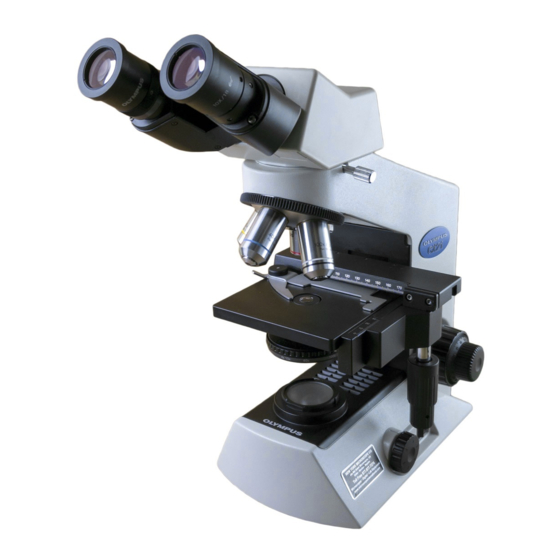Olympus CX21 Інструкція з експлуатації - Сторінка 10
Переглянути онлайн або завантажити pdf Інструкція з експлуатації для Мікроскоп Olympus CX21. Olympus CX21 28 сторінок. Education microscope
Також для Olympus CX21: Посібник з технічного обслуговування (25 сторінок)

DETAILED OBSERVATION PROCEDURE
1
Turning the Lamp ON
2
Placing Specimen on the Stage
@
³
Slide glass
Placing Specimen
7
@
²
Fig. 4
²
|
5
Fig. 5
Cover glass
Fig. 6
1. Set the main switch 1 to " I " (ON).
2. Rotating the light intensity adjustment knob 2 in the direction of the
arrow increases brightness and rotating it in the opposite direction de-
creases brightness. The figures around the knob indicate the reference
voltage values.
# Place the specimen gently. If the bow-shaped lever is returned with
a strong force or the knob 1 of the bow-shaped lever is released in
the middle, the slide glass may be broken.
1. Rotate the coarse adjustment knob 2 in the direction of the arrow to fully
lower the stage.
2. Open the bow-shaped lever 3 outward, place the specimen by sliding
the specimen glass plates on the stage from the front toward the rear.
3. After sliding the specimen glass plates all the way, return the bow-shaped
lever 3 gently.
4. Rotating the upper knob which is the Y-axis feed knob 4 moves the
specimen in the vertical direction. Rotating the lower knob which is the X-
axis feed knob 5 moves it in the horizontal direction.
# Do not move the specimen holder directly by hand, for this will
damage the rotary mechanisms of the above knobs.
# When the specimen holder reaches the stopper position, the
rotation force of the above knobs become heavy. Stop rotating
the knob at this time.
Cover glass
This is the glass plate placed on the specimen. To allow the objective
manifest the full performance, the cover glass thickness, which is the
distance from its surface to the specimen surface, should ideally be
0.17 mm.
Slide glass
This glass plate should ideally have a length of 76 mm, width of 26
mm and thickness between 0.9 and 1.4 mm.
(Fig. 4)
(Fig. 5)
